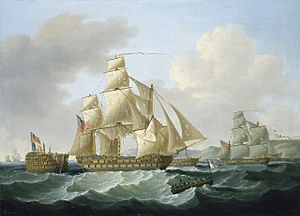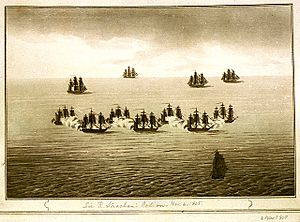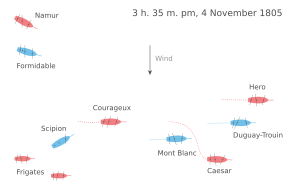Battle of Cape Ortegal facts for kids
Quick facts for kids Battle of Cape Ortegal |
|||||||
|---|---|---|---|---|---|---|---|
| Part of the Trafalgar campaign of the War of the Third Coalition | |||||||
 Bringing Home the Prizes, Francis Sartorius |
|||||||
|
|||||||
| Belligerents | |||||||
| Commanders and leaders | |||||||
| Strength | |||||||
| 4 ships of the line 4 frigates |
4 ships of the line | ||||||
| Casualties and losses | |||||||
| 135 killed or wounded | 730 killed or wounded 4 ships of the line captured |
||||||
The Battle of Cape Ortegal was the last big fight of the Trafalgar campaign. It happened on November 4, 1805. This battle was between ships from the Royal Navy (British) and some French ships. These French ships had escaped an earlier huge battle, the Battle of Trafalgar.
The fight took place near Cape Ortegal in north-west Spain. In this battle, Captain Sir Richard Strachan led the British. He managed to defeat and capture a French group of ships led by Admiral Pierre Dumanoir le Pelley. People sometimes call this battle "Strachan's Action."
Admiral Dumanoir had been at the front of the French fleet during the Battle of Trafalgar. He got away from that battle without much damage. He first tried to sail into the Mediterranean. But he was worried about meeting strong British forces there. So, he changed his mind. He decided to sail north around Spain to reach French ports on the Atlantic coast.
On his journey, he met two British frigates (smaller, fast warships) and chased them away. Soon after, he chased another British frigate. This frigate led Dumanoir right to a British squadron (a group of warships) led by Strachan. Strachan was looking for a different French group. When Strachan saw the French ships, he immediately started chasing them. Dumanoir tried to escape because Strachan had more ships.
Strachan's ships took some time to get into formation. But he used his faster frigates to bother and slow down the French ships. This allowed his bigger ships of the line (large warships) to catch up. After many hours of fierce fighting, Strachan outsmarted Dumanoir. He managed to attack the French ships from two sides. The French ships were then overwhelmed and had to surrender. All four French ships were taken back to Britain. They were then used by the British Navy. Strachan and his men were greatly rewarded. People saw this victory as finishing what Nelson started at Trafalgar.
Contents
Why the Battle Happened
Dumanoir's Escape
Four French ships of the line escaped the Battle of Trafalgar. They were led by Admiral Pierre Dumanoir le Pelley. After the battle, they sailed south. Dumanoir first wanted to go to Toulon. But the next day, he changed his mind. He remembered that a strong British group of ships was near the Straits of Gibraltar.
A storm was also getting stronger off the Spanish coast. So, Dumanoir sailed west past Cape St Vincent. Then he turned north-west. His plan was to sail east across the Bay of Biscay. He wanted to reach the French port at Rochefort. His group of ships was still strong. They had only minor damage from Trafalgar. Dumanoir's ship, Formidable, even threw 12 guns overboard to make itself lighter and escape faster. He passed Cape St Vincent on October 29. By November 2, he was in the Bay of Biscay.
British Ships Spot the French
Several British ships were already in the Bay of Biscay. They were looking for French ships. One of these was the 36-gun HMS Phoenix. It was commanded by Captain Thomas Baker. Baker was supposed to patrol west of the Scilly Isles. But in late October, he heard from merchants that another French group had been seen in the Bay of Biscay.
Baker immediately sailed south. On November 2, he reached the area of Cape Finisterre. This was just as Dumanoir was entering the bay. At 11 AM, Baker saw four ships sailing north-north-west. He immediately chased them. These ships were Dumanoir's, though Baker thought they were from Rochefort. At noon, the French ships turned and started chasing Phoenix. Baker fled south, hoping to lead the French ships towards a British group led by Captain Sir Richard Strachan. Baker knew Strachan was in the area.
Baker stayed ahead of the French ships. At 3 PM, he saw four more sails heading south. Dumanoir's ships also saw them. They turned east. Baker, no longer chased, watched the French ships. After seeing how strong the French ships were, Baker sailed south-east. He fired guns and signaled to the four ships he thought were British.
Dumanoir's ships had already met some British ships. Two frigates, HMS Boadicea and HMS Dryad, had chased them. Boadicea and Dryad saw Phoenix and the four ships to the south at 8:45 PM. They sent signals. Baker was careful about the new ships. He did not go towards them. Instead, he kept going towards the ships in the south.
It became clear to Boadicea and Dryad that many ships were gathering. Phoenix got close to four ships of the line. Three other ships were also seen nearby. Boadicea and Dryad got within two miles of the 80-gun HMS Caesar. But they got no reply to their signals. They sailed away at 10:30 PM. After that, they lost sight of both the French and British ships. They did not take part in the battle.
Strachan Starts the Chase
By 11 PM, Baker finally reached the ships. He passed behind Caesar and learned they were Strachan's squadron. Baker told Strachan that he had seen French ships. Strachan immediately decided to fight them.
However, Strachan's ships were spread out. After setting sail to find the French, he sent Baker to gather the other ships. Baker was to tell them to come support him. Strachan's squadron included the 80-gun Caesar, the 74-gun Hero, Courageux, Namur and Bellona. It also had the frigates Santa Margarita (36-gun) and Aeolus (32-gun).
Strachan started the chase with only Caesar, Hero, Courageux, and Aeolus. They chased the French, who were sailing fast to the north-west. They lost sight of them in hazy weather at 1:30 AM. They then slowed down to wait for the rest of the squadron. At daylight on November 3, Santa Margarita joined them.
The chase started again. At 7:30 AM, Cape Ortegal was seen, 36 miles to the south-east. The French ships were seen again at 9 AM. At 11 AM, the lead British ships saw Namur and Phoenix behind them, hurrying to catch up. With them was another frigate, the 38-gun HMS Révolutionnaire. Its captain, Hon. Henry Hotham, had found the chase by chance. The chase continued all day and into the night. By then, the faster Santa Margarita and Phoenix were far ahead of the main British force. Bellona could not rejoin the squadron and did not take part in the battle.
The Battle Begins
The battle started at 5:45 AM on November 4. Santa Margarita got close to the back of the last French ship, Scipion. It opened fire. Phoenix joined in at 9:30 AM. At this point, the French ships were sailing side-by-side. Phoenix and Santa Margarita were firing at Scipion's back.
Strachan was about six miles behind the French with Caesar, Hero, and Courageux. Aeolus was with them. Namur and Révolutionnaire were further behind. The British ships kept catching up to the French. Scipion fired back at the frigates from its stern guns.
At 11:45 AM, it was clear a battle could not be avoided. Dumanoir ordered his ships to form a line, sailing on the starboard side. Strachan also lined up his ships. He approached from the windy side, on the French ships' starboard side.
By noon, all four British frigates were fighting. They were attacking Scipion on its port side. Namur had almost joined the ships of the line. These larger ships were firing on the back French ships' starboard side. Dumanoir had ordered his ships to turn one after another at 11:30 AM. This was to bring his lead ship, Duguay-Trouin, into the fight. Duguay-Trouin did not obey the signal until 12:15 PM.
The French line began to turn towards the British ships of the line. They started to pass alongside them. Dumanoir had planned this move earlier, but cancelled it. The two lines of ships passed each other. Dumanoir found that Strachan had attacked from two sides. There were frigates on one side and ships of the line on the other. His ships were badly damaged as the British and French lines passed by. Dumanoir tried to cut off Namur before it could join the British line.
The damage to his ships made them slow and hard to steer. Strachan was able to order his ships to turn. This kept them alongside the French ships. He also added Namur to his line. The French ships were under heavy fire. Frigates fired from the starboard side, and ships of the line fired from their port side. The French ships were worn down. By 3:10 PM, Scipion and Formidable were forced to surrender.
Seeing what happened, Mont Blanc and Duguay-Trouin tried to escape. But Hero and Caesar chased them down. They were forced to surrender by 3:35 PM.

What Happened After
Strachan's victory finished the defeat of the French fleet that Nelson had started at Trafalgar. After the four ships were captured at Cape Ortegal, only five French ships were left from their combined fleet. These remaining ships were stuck in Cadiz.
All four captured French ships were taken to Britain. They were then made part of the Royal Navy. Their crews were sent to prison camps. One of the ships, the former Duguay-Trouin, served the British for 144 years. It was renamed HMS Implacable.
The British crews who fought at Cape Ortegal received big rewards. These were part of the rewards given for the victory at Trafalgar. Captain Sir Richard Strachan was promoted to rear-admiral. All first-lieutenants were promoted to commander. Strachan was also made a member of the Order of the Bath. His captains received gold medals.
Dumanoir was not as lucky. He and other French officers were held in Tiverton. They had a lot of freedom there. They just had to be inside the town gates by 8 PM in summer and 4 PM in winter. While there, he wrote to The Times newspaper. He complained about bad comments made about his actions at Trafalgar.
He was released in 1809 and went back to France. There, he faced two official investigations. One was for his actions at Trafalgar. The other was for his defeat at Cape Ortegal. In the first investigation, he was accused of not following orders. He was also accused of not helping his admiral enough. And he was accused of running away from the battle instead of fighting. After looking at the evidence, Dumanoir was found innocent of all charges.
At the second investigation, Dumanoir was found guilty. He was blamed for not attacking Strachan's ships when they were disorganized. He was also blamed for letting the British frigates bother his ships without fighting them. And he was blamed for only turning to fight Strachan when his ships were already being defeated. The court decided he had been too slow to make decisions. The decision was sent to the Minister of Marine in January 1810. But the Minister, Denis Decrès, did not want to order a court-martial (a military trial). Napoleon wanted Dumanoir to be punished as an example. But Decrès tried to protect Dumanoir. When he finally held a court-martial because Napoleon insisted, its orders were unclear. In the end, Dumanoir and the surviving captains were found innocent.
Ships in the Battle
Here are the ships and their commanders that fought in the Battle of Cape Ortegal. It also shows how many sailors were killed or wounded on each ship.
| Captain Strachan's Squadron (British) | ||||||||||
|---|---|---|---|---|---|---|---|---|---|---|
| Ship | Type | Guns | Navy | Commander | Casualties | Notes | ||||
| Killed | Wounded | Total | ||||||||
| HMS Caesar | Third rate | 80 | Captain Sir Richard Strachan | 4 | 25 | 29 | ||||
| HMS Hero | Third rate | 74 | Captain Hon. Alan Gardner | 10 | 51 | 61 | ||||
| HMS Courageux | Third rate | 74 | Captain Richard Lee | 1 | 13 | 14 | ||||
| HMS Namur | Third rate | 74 | Captain Lawrence Halsted | 4 | 8 | 12 | ||||
| HMS Santa Margarita | Fifth rate | 36 | Captain Wilson Rathbone | 1 | 1 | 2 | ||||
| HMS Aeolus | Fifth rate | 32 | Captain Lord William FitzRoy | 0 | 3 | 3 | ||||
| HMS Phoenix | Fifth rate | 36 | Captain Thomas Baker | 2 | 4 | 6 | ||||
| HMS Révolutionnaire | Fifth rate | 38 | Captain Hon. Henry Hotham | 2 | 6 | 8 | ||||
| Total British Casualties: 24 Killed, 111 Wounded, 135 Total | ||||||||||
| Rear-Admiral Dumanoir le Pelley's Squadron (French) | ||||||||||
|---|---|---|---|---|---|---|---|---|---|---|
| Ship | Type | Guns | Navy | Commander | Casualties | Notes | ||||
| Killed | Wounded | Total | ||||||||
| Formidable | Third rate | 80 | Rear-Admiral Pierre Dumanoir le Pelley | - | - | c. 200 | Captured, became HMS Brave | |||
| Scipion | Third rate | 74 | Captain Charles Berrenger | - | - | c. 200 | Captured, became HMS Scipion | |||
| Duguay-Trouin | Third rate | 74 | Captain Claude Touffet † | - | - | c. 150 | Captured, became HMS Implacable | |||
| Mont Blanc | Third rate | 74 | Captain Guillaume-Jean-Noël de Lavillegris | - | - | c. 180 | Captured, became HMS Mont Blanc | |||
| Total French Casualties: 730 killed and wounded | ||||||||||
| Sources: Adkin, p. 535; Fremont-Barnes, p. 86 | ||||||||||
Key
- † Officer killed during the action or later died from wounds.
See also
 In Spanish: Batalla del Cabo Ortegal para niños
In Spanish: Batalla del Cabo Ortegal para niños




